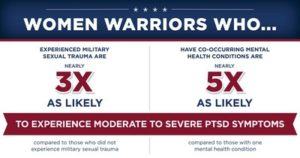
A special report from Wounded Warrior Project highlights risk factors that contribute to PTSD symptoms in women veterans, including military sexual trauma (MST) and co-occurring mental health challenges.
NEW ORLEANS — Anxiety isn’t just mental. It can also cause physical symptoms, such as heart palpitations, sweaty palms or shortness of breath. Anxiety sensitivity reflects the belief that those bodily sensations are harmful and dangerous.
“For example, an individual with elevated levels of anxiety sensitivity might misinterpret normal bodily sensations, such as a racing heart, as being an indicator of heart problems. On the other hand, someone with low anxiety sensitivity would simply regard this sensation as uncomfortable and nonthreatening,” Chelsea Ennis, PhD, a clinical psychologist at the Southeast Louisiana Veterans Health Care System in New Orleans told U.S. Medicine.
Stressful life events can lead to increased anxiety sensitivity, and a new study led by Ennis examines the association between anxiety sensitivity and post-traumatic stress disorder (PTSD) among female veterans who’ve experienced military sexual trauma. The researchers said they primarily wanted to determine whether anxiety sensitivity may increase trauma-related symptoms. “This is particularly important, because we have interventions that can reduce anxiety sensitivity symptoms, which also may in turn reduce PTSD symptoms,” Ennis pointed out.1,2
Military sexual trauma includes sexual assault or repeated sexual harassment that occurs during military service. While its true prevalence remains unknown due to underreporting, one analysis found that more than 34% of female veterans and personnel experience military sexual trauma. In addition, research shows that this trauma is linked with a number of psychiatric conditions, particularly PTSD, and the association between the two conditions is nearly three times stronger among women than men.
The researchers recruited a group of 50 women veterans receiving psychological services at a VA hospital clinic specializing in military sexual trauma. The participants completed a diagnostic interview and self-report questionnaires. Thirty-eight percent of the women had a primary diagnosis of PTSD (the most commonly diagnosed mental health disorder), while 22% were diagnosed with depressive disorder, and 10% were diagnosed with anxiety disorder.
Strong Link
The researchers found a strong link between PTSD symptom severity and anxiety sensitivity among the participants. PTSD was the most common mental health disorder, followed by a depressive, anxiety and/or personality disorder. The vast majority—82%—of study participants said military sexual trauma was their worst traumatic event for the purposes of assessing PTSD (only 4% identified military combat as their worst event). To better understand the relationship between anxiety sensitivity and PTSD, the researchers controlled for depression, which can contribute to symptom severity and often accompanies PTSD.
The overall findings were consistent with previous research showing higher anxiety sensitivity is associated with more severe PTSD. However, the research team said they were somewhat surprised by specific associations with certain PTSD symptom clusters.
PTSD is characterized by a variety of symptoms that are grouped together due to their similarity, with four clusters of symptoms: intrusion (such as nightmares or distressing memories), avoidance (of people, places or things that are reminders of the traumatic event), negative thoughts and emotions (such as beliefs that the world is dangerous or a lack of positive emotions) and arousal (such as hypervigilance). The study found that anxiety sensitivity was related to two of the four clusters: negative thoughts and emotions and arousal.
Importantly, Ennis advised that the research provides further evidence that treating individuals’ anxiety sensitivity could, in turn, reduce their symptoms of PTSD. Mounting evidence shows that brief psychological treatments designed to combat myths regarding the danger of physical symptoms of anxiety, coupled with repeated exposure to these sensations (known as interoceptive exposure), could also be helpful in reducing anxiety sensitivity. However, she says research is still needed to determine whether targeting anxiety sensitivity is effective at reducing PTSD symptoms specifically among women who have experienced military sexual trauma.
“For example, for someone who really fears their heart is racing because they’re worried that they’re going to have a heart attack, we may have them run in place over and over again to get them used to that physical sensation. Or for someone who gets really nervous when their breathing changes when they’re anxious, we may have them hyperventilate over and over again to show them that there’s no danger in hyperventilating and that nothing bad happens,” Ennis recounted “The goal of these types of interventions is for individuals to become more comfortable with the sensations of anxiety so they no longer fear them.”
Ennis said interoceptive exposure could be used to accompany the two gold-standard psychotherapies for PTSD: Cognitive Processing Therapy (CPT) and Prolonged Exposure (PE). “Both of these treatments are widely available within the VA and have decades of research demonstrating their effectiveness in reducing trauma-related symptoms.”
-
McLaughlin, KA, Hatzenbuehler, ML Stressful Life Events, Anxiety Sensitivity, and Internalizing Symptoms in Adolescents. Journal of Abnormal Psychology. Published August 2009. DOI: 10.1037/a0016499.
-
Ennis, Chelsea R., Raines, Amanda M., Ebert, Kenna R., Franklin, C. Laurel. Anxiety sensitivity and posttraumatic stress symptoms: Associations among female Veterans with a history of military sexual trauma. Military Psychology. Published September 21, 2021. DOI: 10.1080/08995605.2021.1962188.

